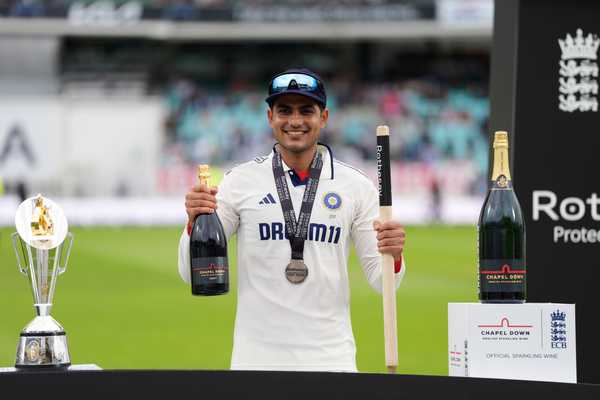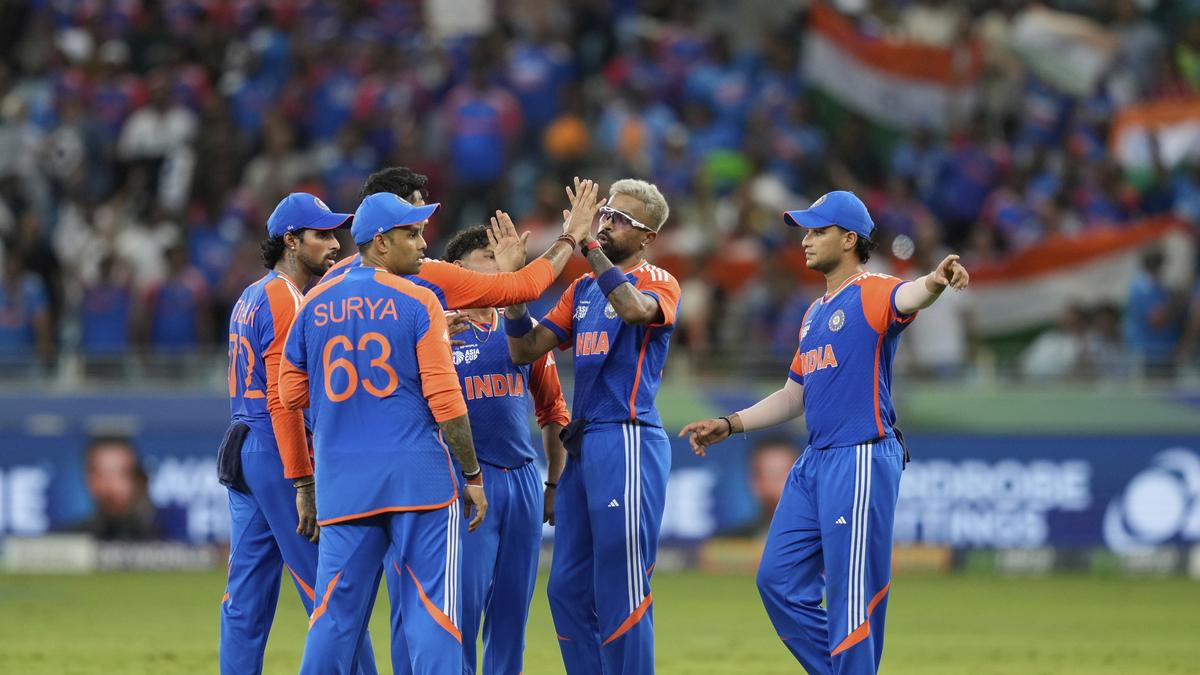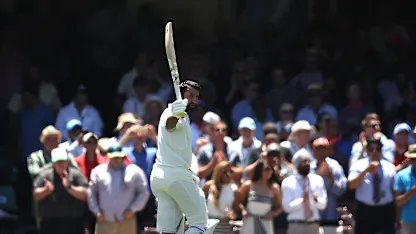INDIA TOUR OF ENGLAND, 2025

India’s player of the series – Shubman Gill – finished with the second highest series aggregate by a captain ©Getty
The enthralling finale at the Oval, where India levelled a hard fought series 2-2, saw a more even contest between bat and ball. But much of the series leading up to it had the willow dominating leather for the most part that saw batters mounting unscaled peaks that eventually led to just one seamer standing by the end of the series. A detailed look into the series as batters from both sides made merry…
Runs, runs and more runs
6736 runs scored by batters in the series is the second highest for a Test series ever, only 20 runs shy of 6756 runs in Ashes 1993 in England which was a six-Test series. India’s batters cumulatively aggregated 3580 runs in the series that happens to be the second highest by a team in a series behind England’s 3640 in Ashes 1928/29 Down Under.
England batters managed 3156 runs between them, that sits eighth in the list and makes it only the second rubber after Frank Worrell Trophy 1968/69 where both teams tallied 3000+ runs. Then, the hosts Australia scored 3395 runs while the visiting West Indies replied with 3122 runs.
Most runs in a Test series
| Teams | Host | Runs | Mat | Season |
|---|---|---|---|---|
| Eng vs Aus | England | 6756 | 6 | 1993 |
| Eng vs Ind | England | 6736 | 5 | 2025 |
| Aus vs Eng | Australia | 6606 | 5 | 1928/29 |
| Aus vs WI | Australia | 6517 | 5 | 1968/69 |
| Aus vs Eng | Australia | 6460 | 5 | 1924/25 |
The series also witnessed 1000+ run tally getting breached in each of the five Tests, the 12th instance of it happening five-plus times in a series. The last such instance also came between these two teams – in India in 2016/17.
India’s tally of 1014 runs in the second Test in Edgbaston (587 & 427/6d) is the fourth highest by a team in a Test and the second highest in a time-bound Test after Pakistan’s 1078 runs against India in Faisalabad in 2006.
In the opening Test of the series at Leeds, India tasted defeat despite scoring 835 runs – the fourth highest run aggregate by a team that ended on the losing side.
There were 14 totals in excess of 350 in the series, the most ever in a rubber, surpassing the previous tally by four in Ashes 1928/29 in Australia and Ashes 1948 in England. India contributed six of these, making it the most for team in a series.
Teams batted 80+ overs in 14 of the 19 innings in the series, making it the second most for a series in the 21st century behind 16 in the West Indies – South Africa series in 2001.
Each of the five Tests were concluded on the fifth day, making it only the fourth such instance since 2000 after the South Africa tour of West Indies in 2001, England tour of South Africa in 2004/05 and Ashes 2017/18 in Australia.
Hundreds galore
21 Individual centuries posted in the series – the joint most alongside the Australia – West Indies rubber in 1955. Harry Brook fell one short of the three-figure mark at his home ground in Leeds, which would have given the record to this series. The record for a Test series in England previously was only 15 in the series between the two teams back in 1990. India’s batter smashed 12 hundreds in the series, the joint most by a team in a series. Ten of the 21 centuries were scored in the second innings, surpassing the previous series record of eight.
Most 100s by a team in a series
| Team vs oppn | Host | 100s | Mat | Season |
|---|---|---|---|---|
| Aus vs WI | West Indies | 12 | 5 | 1955 |
| Pak vs Ind | Pakistan | 12 | 6 | 1982/83 |
| SA vs WI | South Africa | 12 | 4 | 2003/04 |
| Ind vs Eng | England | 12 | 5 | 2025 |
12 different batters made three-figure scores in the series – six each from India and England – the joint most in a series alongside the Australia – West Indies series in 1955. Among those who batted at least four times in the top seven in the series, only three batters failed to breach the three-figure mark – Zak Crawley (nine innings, highest score 84), Karun Nair (eight innings, highest score 57), and Sai Sudharshan (six innings, highest score 61).
There were 50 scores of fifty or more (including 21 hundreds) across 196 individual innings in the series, the joint most alongside Ashes 1993, which spanned six Tests. There was a 50+ score every 3.9 innings – the best ever for a series of five matches or more in this century.
The 50-100 conversion rate of 42% (21 X 100s out of 50 X 50+ scores) is the second best for a five-Test series this century, behind the Wisden Trophy in the Caribbean in 2009, that saw batters getting to 100 17 times out of the 34 times they went past 50.

Shubman Gill, KL Rahul and Ravindra Jadeja all finished with 500+ runs in the series ©Getty
Batters make merry
9 Players aggregating 400+ runs in the series – the most ever in a Test series of any length. The previous most was eight each in the Frank Worrell Trophy 1975/76 in Australia and Ashes 1993 in England.
Three Indian batters aggregated 500+ runs in the series (Shubman Gill 754, KL Rahul 534, & Ravindra Jadeja 516) – the sixth time it was done by a team in a Test series and the first such instance since Australia in Ashes 1989 in England. The previous instances being South Africa in England in 1947 (Dudley Nourse, Bruce Mitchell, & Alan Melville), Australia at home against West Indies in 1968/69 (Doug Walters, Bill Lawry, & Ian Chappell), West Indies in England in1976 (Vic Richards, Gordon Greenidge, & Roy Fredericks), Pakistan at home against India in 1982/83 (Mudassar Nazar, Zaheer Abbas, & Javed Miandad) and Australia in Ashes 1989 (Mark Taylor, Dean Jones, & Steve Waugh).
Jadeja’s tally of 516 runs is the sixth instance of a batter scoring 500+ runs in a series batting #6 or lower and the first such occurrence since Shivnarine Chanderpaul’s 562 run series against India at home in 2002.
Gill stands tall
754 – India’s skipper Shubman Gill finished the series with 754 runs to his name, 217 runs ahead of any other batter from either side. It happens to be the second highest series tally for an Indian batter, only behind Sunil Gavaskar’s 774 runs in four Tests in his debut series, in the Caribbean in 1970/71.
Gill’s 754 is the second highest series aggregate by a captain after Don Bradman’s 810 runs in Ashes 1936/37. Coincidentally, the efforts of both Bradman and Gill came in their maiden instance of leading their team.
This was the 21st instance of a batter tallying north of 750 runs in a series and only the fifth time they did not go on to win the series. Clyde Walcott’s 827 runs against Australia at home in 1955 wasn’t enough to prevent a 0-3 defeat while Neil Harvey’s 834 against South Africa at home in 1952/53, Steven Smith’s 774 in Ashes 2019, and Brian Lara’s 765 in England in 1995 all ended in 2-2 stalemates.
Gill managed to hit four hundreds in the series, the joint-most by a captain. Bradman hit four in his final home series in 1947/48 against India while Gavaskar also hit four against West Indies at home in 1978/79. Gill’s tally of four centuries also happen to be the joint-most by an Indian batter in a series along with Gavaskar against West Indies – away in 1970/71 and at home in 1978/79 – and Virat Kohli Down Under in 2014/15.
Most runs for India in a series
| Batter | Runs | Mat | Against | Season |
|---|---|---|---|---|
| S Gavaskar | 774 | 4 | WI (Away) | 1970/71 |
| S Gill | 754 | 5 | Eng (Away) | 2025 |
| S Gavaskar | 732 | 6 | WI (Home) | 1978/79 |
| Y Jaiswal | 712 | 5 | Eng (Home) | 2023/24 |
| V Kohli | 692 | 4 | Aus (Away) | 2014/15 |
| V Kohli | 655 | 5 | Eng (Home) | 2016/17 |
Keepers make a mark in front of the wickets
966 Runs scored by designated wicketkeepers in the Anderson-Tendulkar Trophy, 2025 – 479 by Rishabh Pant, 434 by Jamie Smith, and 53 by Dhruv Jurel. The tally comfortably surpasses the previous highest aggregate for wicketkeepers in a series, which was 756 in the series between India and England in India in 1963/64. Pant and Smith became the first pair of wicketkeepers to aggregate 400+ runs in the same series.
Pant’s tally of 479 runs is the highest by a wicketkeeper in a series in England, surpassing Alec Stewart’s 465 against South Africa in five Tests in 1998 while Smith sits third in the list.
272 runs scored by Jamie Smith in the Edgbaston Test – 184* and 88 – is the third most by a designated wicketkeeper in a Test, behind Andy Flower twin efforts of 341 runs against South Africa in Harare in 2001 and 287 runs against India in Nagpur in 2000. Pant’s effort of 252 runs in the series opener at Leeds (134 & 118) is the fifth in the list as he became only the second wicketkeeper after Andy Flower (142 & 199* vs SA in Harare 2001) to score hundreds in each innings of a Test.
Hunting in pairs
19 – Partnerships of 100 or more in the series – the joint most in a series. There were as many in the five-Test rubber between West Indies and Pakistan in 1957/58 as well as England against West Indies in 1967/68, both in the Caribbean. India accounted for 11 of these, which is the joint most for them along with 11 in the six-match rubber against West Indies at home in 1978/79. Gill was involved in as many as six 100+ stands, the most by a player from either side.
There six stands worth 150 or more in the second innings, the highest ever in a series, bettering the previous record of four. India had four 150+ stands in the third innings while for England they came in fourth innings chases.
© Cricbuzz





